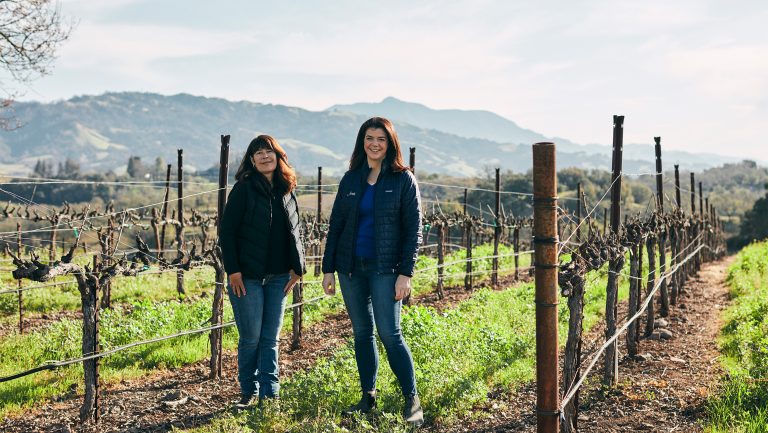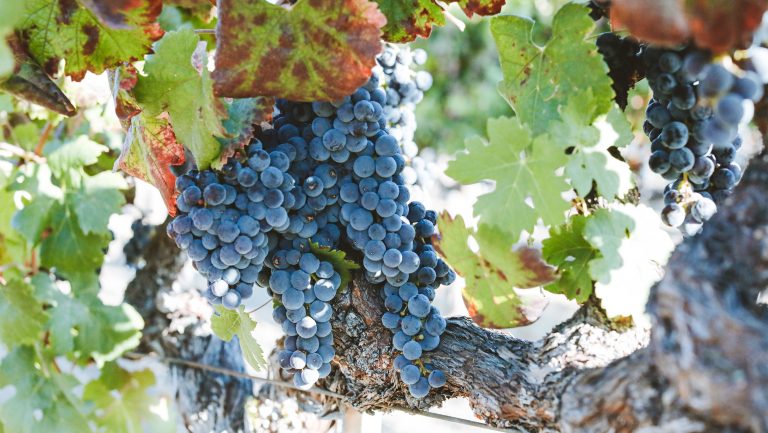Since its founding in 1972, Jordan Vineyard & Winery in Healdsburg has produced a Cabernet Sauvignon that, according to winemaker Maggie Kruse, often “just skirts by” California’s requirement that at least 75 percent of the wine be made from the named grape variety. Like many of France’s top producers, Jordan has always used Merlot to help tame Cabernet Sauvignon’s tannins and add red-fruit flavor.
Merlot is critical to wineries that produce Bordeaux-style blends—but over the last 20 years, it’s become increasingly challenging to find. According to data from the USDA’s annual grape reports, California winemakers crushed 305,000 tons of Merlot in 2000 and 310,000 tons in 2010. The volume fell to 220,000 tons in 2019—a year in which total tons crushed in California surpassed both the 2000 and 2010 vintages.
Those same grape reports show an even bleaker outlook for Merlot in quality North Coast regions: The Merlot tons crushed in Sonoma and Marin Counties dropped 60 percent between 2000 and 2019, while tons crushed in Napa County dropped by 55 percent over the same time period.

Don’t miss the latest drinks industry news and insights. Sign up for our award-winning newsletters and get insider intel, resources, and trends delivered to your inbox every week.
With less Merlot available, some winemakers have been forced to alter their blends—and the style of their wines. “Our Merlot percentage used to be around 20 percent. Now it’s 12 to 15 percent or even lower in some vintages,” says Kruse. While she has used estate-grown Petit Verdot and Malbec as blenders, “they aren’t that same silky smooth softener. If we can’t find enough Merlot, it’s going to be a struggle to keep our tannins in check.”
Napa vintners are also struggling to find the famous blender. Joshua Lowell, the general manager of Sullivan Rutherford Estate in Rutherford, believes in Napa, there is little to no top-quality Merlot growing on high-quality soils with the same meticulous farming methods used to produce Cabernet Sauvignon. Although it hasn’t always been this way, in this day and age, “Merlot plays second fiddle—or third or fourth—to Cabernet,” he notes. That’s a problem for brands like his that make both Bordeaux-style blends and varietal Merlots.
Rather than writing off Bordeaux-style blends, Kruse, Lowell, and other California wine professionals are exploring the many roots of this problem and looking for ways to fix it—including planting Merlot themselves, signing longer (and higher-priced) contracts, and advocating for the many quality varietal Merlots that do exist and can help bring positive attention back to this much-maligned grape.
Lower Prices Drive Down Plantings
Kruse points to the Sideways effect as one reason why Merlot is in short supply in California, but at the end of the day, there’s another famous movie reference that seems more fitting: “Show me the money.”
Merlot is much less profitable than Cabernet Sauvignon. USDA data puts the price of Merlot in California at $661 per ton in 2020—nearly half of Cabernet’s $1,233 per ton. Kruse’s experience is that the price of Merlot is 30 to 40 percent lower than what people will pay for Cabernet Sauvignon.
This puts growers in a bind. If they need to replant, it doesn’t make sense to invest in grapes that will fetch a smaller return. If they’re forced to remove vineyards to make space for a winery or other improvements, Merlot may be the first thing they pull up.

California grape prices have generally been on the decline since 2018, says Glenn Proctor, the global wine and grape broker at Ciatti Company. “Growers are having some challenges making ends meet, especially as costs continue to go up,” he explains.
Ironically, while these low prices are driving down the supply of Merlot statewide, it’s also increasing competition in Sonoma specifically. Sonoma fruit tends to be cheaper than nearby Napa fruit, says Kruse, causing Napa wineries to turn to its neighboring county for Merlot. That increased competition is making it harder than ever to secure grapes.
High-Quality Grapes Become Harder to Find
Kruse points out that part of Jordan’s struggle is finding great, not just good, Merlot—a problem that stems from not just the overall shortage, but from the continued exploration of California’s terroir.
Jesse Katz, the founder and winemaker at Aperture Cellars in Healdsburg, points out that California is still a relatively young winegrowing region. Since the state’s modern wine culture first emerged, growers have planted the varieties that are most popular, not those that are likely to thrive on the site. “We’re getting so much better at understanding what rootstocks and clones work with different soil types,” he points out.
Eva Dehlinger, the general manager of Dehlinger Winery in Sebastopol, has watched this scenario play out in real time. Her father, Tom, wanted to make great Bordeaux-style blends, so he planted Cabernet Sauvignon, Merlot, and Cabernet Franc during his early days on the property. Although the wines were well received, he ended up keeping only the Cabernet Sauvignon and grafting the Merlot and Cabernet Franc over to other varieties.
Looking back, Dehlinger believes this was attributable to the vines being in the wrong spot, not a desire to stop producing Merlot. “We were getting to know our property at the time. It’s a cooler site, and the Merlot and Cabernet Franc were not planted in the right spots on our property,” she says. “[My father] always said that they would do very well in the Russian River Valley if they were planted on premium, red-wine soils.”
There’s no doubt in her mind that Merlot can succeed in Sonoma. “People who have stuck with it in great terroirs are making great wine and great blends,” says Dehlinger, pointing to Pride Mountain Vineyards as one example.
“A lot has changed for us and the region over the last several decades,” she adds. Vineyards have much better information about matching rootstocks with various soil types. A warming climate, as well as normal weather variations from vintage to vintage, have demonstrated the benefit of diversity in vineyards. Dehlinger is currently conducting small-scale variety trials that include Merlot and Cabernet Franc with the hope of potentially returning to estate Bordeaux blends or perhaps even doing a single-varietal bottling.
Lowell sees the same challenge playing out in Napa. “It’s too reductive to say Sideways killed Merlot,” he says. “It didn’t do it any favors, but we killed the Merlot in Napa.”
Napa growers have typically dedicated their highest-quality soils to Cabernet Sauvignon, relegating Merlot to lower-quality vineyard areas. Growers also didn’t necessarily invest as much in the quality of the farming in those areas. “[When that happens] you don’t get the same level of concentration and quality, which means you can’t process [those grapes] in the winery as a more serious wine,” says Lowell. Subsequently, the self-fulfilling prophecy that Merlot grown in Napa couldn’t be as good as Cabernet was born. It’s one more hurdle growers interested in boosting supply will need to overcome.
The Future of Merlot in California
It does seem that demand for Merlot is increasing. Five or six years ago, Proctor’s buyers were not requesting it. However, last year, Ciatti did deals for Merlot for three or four buyers. “We haven’t done that for a while,” he notes. “We are seeing increased activity and I expect we will see it going forward.”
But what will it take to actually get Merlot back in the ground so that as demand rises, supply will too?
For some, the solution is to plant it themselves. Sullivan Rutherford recently replanted four acres with Merlot. “From a business standpoint, it’s a crazy move,” says Lowell—but he is so confident that Merlot will do well in the right place and with the right attention that he believes it’s worth it. Three years ago, the brand also bought an undeveloped property in Soda Canyon and replanted it with 75 percent Merlot and 25 percent Cabernet Franc.

When Aperture buys or leases a new vineyard, it conducts intensive soil tests. Even properties that seem well-suited to Cabernet have different soil types, including spots with clay, which can slow down ripening for that variety but are great for Merlot. Merlot goes into those areas, even if it means ripping out Cabernet. Thanks to this approach and close attention to the farming of all grapes, “some of the most prized fruit we bring in every year is Merlot,” Katz says.
Katz is confident that estate plantings of Merlot will increase in the coming years. But for winemakers who don’t have their own property (or don’t have vineyards capable of producing premium Merlot), the consensus is that they will need to commit to paying higher prices for it. The confidence to plant it “is going to come from wineries saying I need it and I’m willing to commit to a contract for those varieties at prices that mean a good return for the growers,” says Proctor.
Proctor compares the current situation with Merlot to a similar set of circumstances 15 years ago, when another Sideways-inspired market shift was taking place. “A lot of people put Pinot Noir in the ground because they saw the market growing and were willing to commit to it,” he says. “We’re going to need to see that kind of interest to increase the availability (of Merlot) long term.”
Indeed, more certainty is something that many vineyard owners are seeking before they plant Merlot vines. Some of the growers Kruse works with are asking for longer contracts and pre-plant contracts before vines go in the ground.
Another change that would likely sweeten the pot for growers is a greater focus on varietal Merlot production. “I still think you’re going to have limited upside if it’s just a blending component,” says Proctor. “Most people are hesitant to pay as much for something they’re putting into a blend as they are for the main variety.”
Still, the need for high-quality Merlot for blending is likely to challenge winemakers who rely on it. At least in the short term, the challenge for winemakers will be to identify the right combination of factors to ensure Merlot remains available.

Dispatch
Sign up for our award-winning newsletter
Don’t miss the latest drinks industry news and insights—delivered to your inbox every week.
Sophia McDonald is a freelance writer who lives in Eugene, Oregon. Her work has appeared in numerous publications and on websites, including Wine Enthusiast, Eating Well, Sip Northwest, and 1859 Oregon’s Magazine.






